Articles
- Page Path
- HOME > Korean J Community Nutr > Volume 16(1); 2011 > Article
-
Original Article
- A Study on Premenstrual Syndrome (PMS), Nutrient Intake, Psychological Index according to the Obesity Degree of College Women
- Se-Na Kang, Jung-Hwa Park, Hye-Jin Hwang
-
Korean Journal of Community Nutrition 2011;16(1):14-22.
DOI: https://doi.org/10.5720/kjcn.2011.16.1.14
Published online: February 28, 2011
1Dongeui Food Research Institute, Dongeui University, Busan, Korea.
2Department of Food and Nutrition, Yonsei University, Seoul, Korea.
3Department of Food and Nutrition, Dongeui University, Busan, Korea.
- Corresponding author: Hye Jin Hwang, Department of Food and Nutrition, Dongeui University, 995 Eomgwangno, Busan-jin Gu, Busan 614-714, Korea. Tel: (051) 890-1594, Fax: (051) 890-2646, hhj2001@deu.ac.kr
Copyright © 2011 The Korean Society of Community Nutrition
- 846 Views
- 5 Download
- 1 Crossref
Figure & Data
REFERENCES
Citations

- Premenstrual symptom clusters and women’s coping style in Korea: happy healthy 20s application study
Chiyoung Cha, Su Jin Nam
Journal of Psychosomatic Obstetrics & Gynecology.2016; 37(3): 91. CrossRef
Physical characteristics of subjects
1) BMI (kg/m2): Body Mass Index
2) PIBW: Percent Ideal Body Weight, ideal body weight = {height (cm) - 100} × 0.9
3) Mean ± SD
4) Significance between normal subjects and overweight or obese subjects by t-test
***: p < 0.001
Hematological index of the subjects
1) Systolic Blood Pressure
2) Diastolic Blood Pressure
3) High density lipoprotein-cholesterol
4) Low density lipoprotein-cholesterol
5) Mean ± SD
6) Significance between normal subjects and overweight or obese subjects by t-test
**: p < 0.01
Average daily nutrient intakes and % KDRIs of the subjects
1) KDRIs: Dietary reference intake of Koreans (2010), 2) Significance between normal subjects and overweight or obese subjects by t-test
*: p < 0.05
Premenstrual syndrome of the subjects
1) Mean ± SD, 1: Not exist, 2: Exist a little, 3: Moderate, 4: Considerable 5: Severe
2) Significance between normal subjects and overweight or obese subjects by t-test
*: p < 0.05, **: p < 0.01
Psyhological score (depression, anxiety, stress) of the subjects
1) 21 questions, 0 - 3 Likert scale
2) 21 questions, 0 - 3 Likert scale
3) 10 qustionss, 0 - 4 Likert scale
4) Mean ± SD
5) Significance between normal and overweight subjects by t-test
*: p < 0.05
Correlation coefficient between premenstrual syndrome and hematological index of the subjects
1) Body Mass Index
2) Percent Ideal Body Weight, ideal body weight = {height (cm) - 100} × 0.9
3) Systolic blood pressure
4) Diastolic blood pressure
5) High density lipoprotein-cholesterol
6) Low density lipoprotein-cholesterol
*: p < 0.05, **: p < 0.01
Correlation coefficient between premenstrual syndrome and nutrient intakes of the subjects
*: p < 0.05, **: p < 0.01
Correlation coefficient between premenstrual syndrome and psychological score (depression, anxiety, stress) of the subjects
*: p < 0.05, **: p < 0.01
1) BMI (kg/m2): Body Mass Index 2) PIBW: Percent Ideal Body Weight, ideal body weight = {height (cm) - 100} × 0.9 3) Mean ± SD 4) Significance between normal subjects and overweight or obese subjects by t-test ***: p < 0.001
1) Systolic Blood Pressure 2) Diastolic Blood Pressure 3) High density lipoprotein-cholesterol 4) Low density lipoprotein-cholesterol 5) Mean ± SD 6) Significance between normal subjects and overweight or obese subjects by t-test **: p < 0.01
1) KDRIs: Dietary reference intake of Koreans (2010), 2) Significance between normal subjects and overweight or obese subjects by t-test *: p < 0.05
1) Mean ± SD, 1: Not exist, 2: Exist a little, 3: Moderate, 4: Considerable 5: Severe 2) Significance between normal subjects and overweight or obese subjects by t-test *: p < 0.05, **: p < 0.01
1) 21 questions, 0 - 3 Likert scale 2) 21 questions, 0 - 3 Likert scale 3) 10 qustionss, 0 - 4 Likert scale 4) Mean ± SD 5) Significance between normal and overweight subjects by t-test *: p < 0.05
1) Body Mass Index 2) Percent Ideal Body Weight, ideal body weight = {height (cm) - 100} × 0.9 3) Systolic blood pressure 4) Diastolic blood pressure 5) High density lipoprotein-cholesterol 6) Low density lipoprotein-cholesterol *: p < 0.05, **: p < 0.01
*: p < 0.05, **: p < 0.01
*: p < 0.05, **: p < 0.01

 KSCN
KSCN
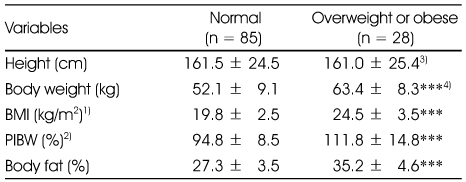
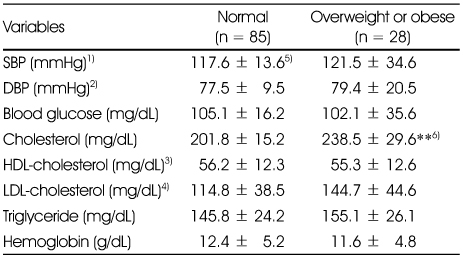
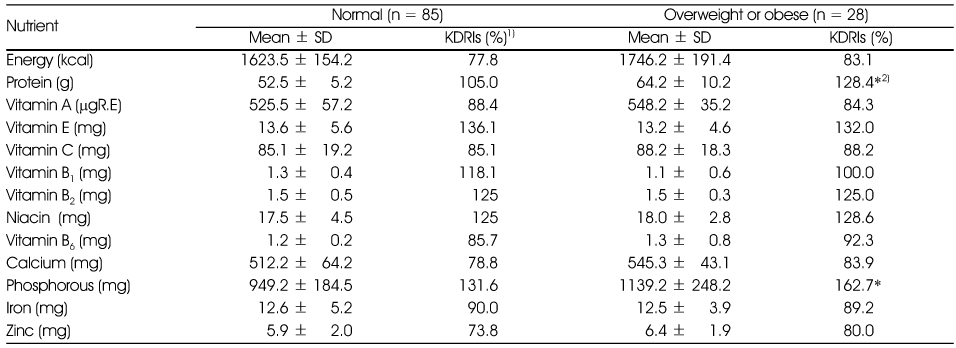
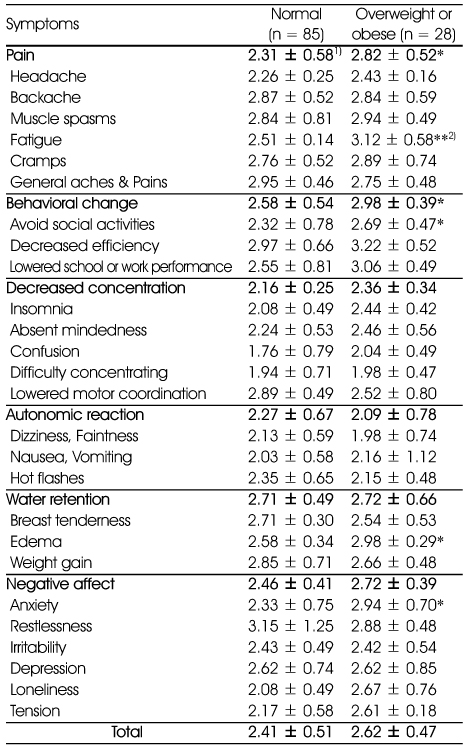

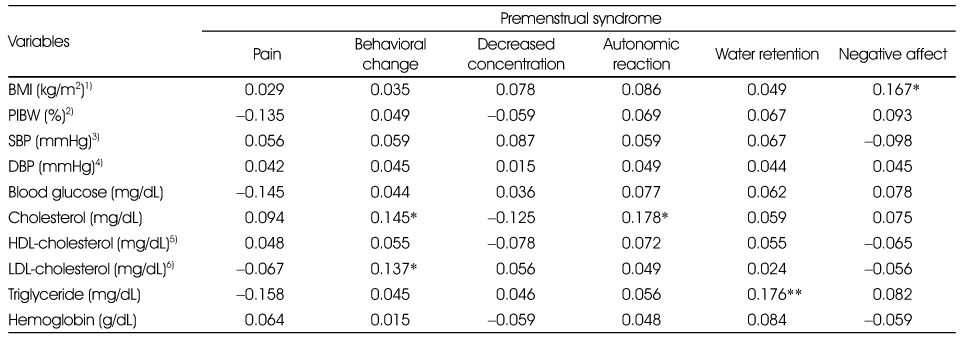
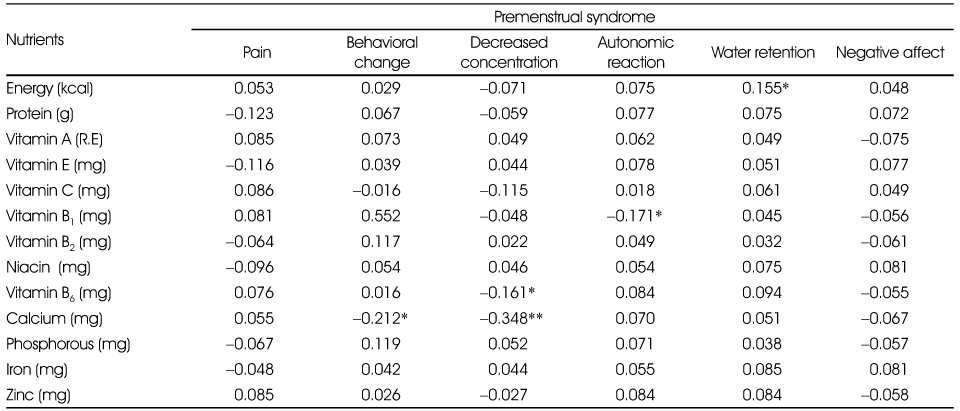

 PubReader
PubReader Cite
Cite


